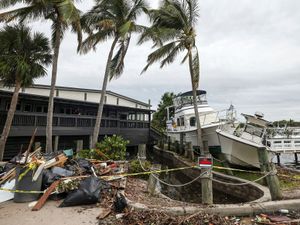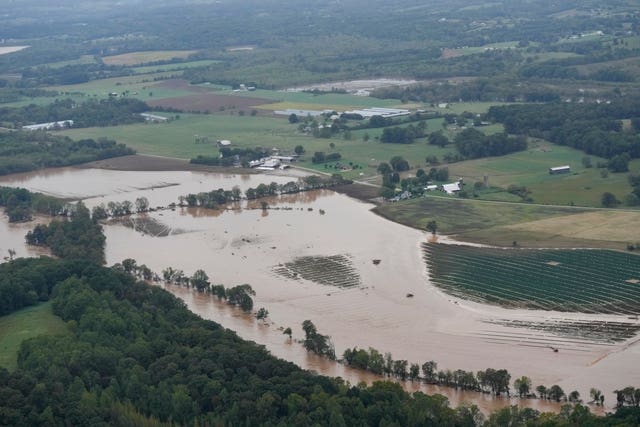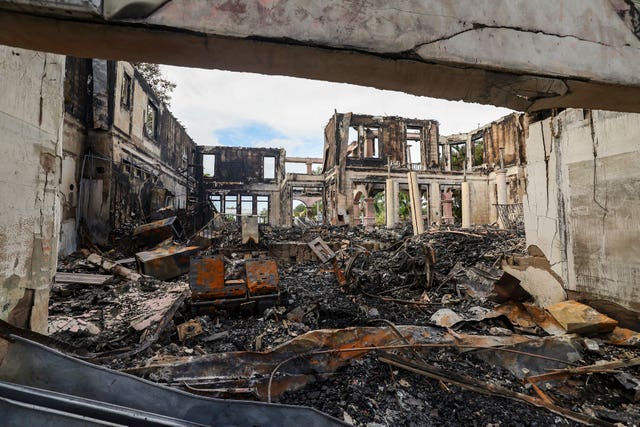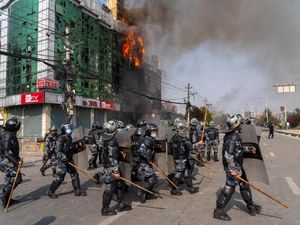Hurricane Helene leaves trail of destruction across southeast of US
At least 64 people have been killed since the storm blew ashore in Florida late on Thursday.

Massive rains from Hurricane Helene left people stranded, without shelter and awaiting rescue after the storm which killed at least 64 people, caused widespread destruction across the southeast of the US and knocked out power to millions of people.
Helene blew ashore in Florida’s Big Bend region as a Category 4 hurricane late on Thursday with winds of 140mph.
It quickly moved through Georgia, where Governor Brian Kemp said on Saturday it “looks like a bomb went off” after viewing splintered homes and debris-covered highways from the air.
Weakened, Helene then soaked the Carolinas and Tennessee with torrential rains, sending creeks and rivers over their banks and straining dams.

Western North Carolina was isolated because of landslides and flooding that forced the closure of Interstate 40 and other roads.
There have been hundreds of water rescues, none more dramatic than in rural Unicoi County in East Tennessee, where dozens of patients and staff were plucked by helicopter from a hospital rooftop on Friday.
The rescues continued into the following day in Buncombe County, North Carolina, where part of Asheville was under water.
“To say this caught us off guard would be an understatement,” said Quentin Miller, the county sheriff.
Asheville resident Mario Moraga said it was “heartbreaking” to see the damage in the Biltmore Village neighbourhood and neighbours have been going house to house to check on each other and offer support.
“There’s no cell service here. There’s no electricity,” he said.
While there have been deaths in the county, emergency services director Van Taylor Jones said he was not ready to report specifics, partially because downed phone towers hindered efforts to contact next of kin. Relatives put out desperate pleas for help on Facebook.

The storm, now a post-tropical cyclone, was expected to hover over the Tennessee Valley on Saturday and Sunday, the National Hurricane Centre said.
It unleashed the worst flooding in a century in North Carolina with one community, Spruce Pine, doused with more than two feet (60cm) of rain from Tuesday through to Saturday.
In Atlanta, 11.12 inches (28.24cm) of rain fell over 48 hours, the most the city has seen over two days since record keeping began in 1878.
President Joe Biden said on Saturday that Helene’s devastation has been “overwhelming” and pledged to send help. He also approved a disaster declaration for North Carolina, making federal funding available for affected individuals.
With at least 25 killed in South Carolina, Helene is the deadliest tropical cyclone for the state since Hurricane Hugo killed 35 people when it came ashore just north of Charleston in 1989.
Deaths also have been reported in Florida, Georgia, North Carolina and Virginia.
Moody’s Analytics said it expects 15 billion dollars to 26 billion dollars in property damage. AccuWeather’s preliminary estimate of the total damage and economic loss from Helene in the US is between 95 billion dollars and 110 billion dollars.

Evacuations began before the storm hit and continued as lakes overtopped dams, including one in North Carolina that forms a lake featured in the movie Dirty Dancing. Helicopters were used to rescue some people from flooded homes.
Among the 11 confirmed deaths in Florida were nine people who drowned in their homes in a mandatory evacuation area on the Gulf Coast in Pinellas County, Sheriff Bob Gualtieri said.
None of the victims were from Taylor County, which is where the storm made landfall. It came ashore near the mouth of the Aucilla River, about 20 miles northwest of where Hurricane Idalia hit last year at nearly the same ferocity.
Taylor County in Florida’s Big Bend went years without taking a direct hit from a hurricane. But after Idalia and two other storms in a little more than a year, the area is beginning to feel like a hurricane superhighway.
“It’s bringing everybody to reality about what this is now with disasters,” said John Berg, 76, a resident of Steinhatchee, a small fishing town and weekend getaway.
Climate change has exacerbated conditions that allow such storms to thrive, rapidly intensifying in warming waters and turning into powerful cyclones sometimes in a matter of hours.
Helene was the eighth named storm of the Atlantic hurricane season, which began June 1.
The National Oceanic and Atmospheric Administration has predicted an above-average season this year because of record-warm ocean temperatures.





